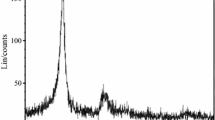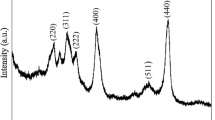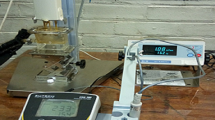Abstract
Stable α-alumina-water-ethylene glycol (WEG) based nanofluids with a low viscosity requirement are preferable for promising engineering applications. Viscosity of nanofluids is a significant parameter that decides the flow characteristics and pumping pressure requirements. In this study, α-alumina nanoparticles (spherical morphology with 40 nm) dispersed in WEG mixture in a ratio of 50:50 (v/v) using an ultra-sonication process. Further analysis of the effects of process parameters on the viscosity of prepared nanofluid, including volume concentrations (0.01%–0.2%), temperatures (30-45 °C), and sonication times (0–4 h). A decrease in viscosity of 11.36% was observed for 0.2% volume concentration as sonication time increased from 0 to 3 h at a process temperature of 45 °C. The viscosity value of nanofluids approaches a stable value at 3 h of sonication. No significant sonication ‘null effect’ was required for lower concentrations irrespective of the temperature and sonication time, yielding low viscosity. At the same time, clusters were observed at a higher volume concentration under a minimal sonication time (1 h) resulting in a higher viscosity. On the other hand, the viscosity of nanofluid was reduced with the help of an increase in sonication duration and process temperature. Statistical analysis ranks a higher degree to volume concentration of nanoparticles.









Similar content being viewed by others
References
Choi, S.U.S.; Eastman, J.A.: Enhancing thermal conductivity of fluids with nanoparticles. Am. Soc. Mech. Eng. Fluids Eng. Div. FED. 231, 99–105 (1995)
Ghadimi, A.; Saidur, R.; Metselaar, H.S.C.: A review of nanofluid stability properties and characterization in stationary conditions. Int. J. Heat Mass Transf. 54, 4051–4068 (2011). https://doi.org/10.1016/j.ijheatmasstransfer.2011.04.014
Murshed, S.M.S.; Estellé, P.: A state of the art review on viscosity of nanofluids. Renew. Sustain. Energy Rev. 76, 1134–1152 (2017). https://doi.org/10.1016/j.rser.2017.03.113
Gbadeyan, J.A.; Titiloye, E.O.; Adeosun, A.T.: Effect of variable thermal conductivity and viscosity on Casson nanofluid flow with convective heating and velocity slip. Heliyon 6, e03076 (2020). https://doi.org/10.1016/j.heliyon.2019.e03076
Zarei, J.M.; Keshavarz, P.; Zerafat, M.M.; Sabbaghi, S.: Experimental investigation on the thermal conductivity of Triethylene Glycol-Water-CuO nanofluids as a desiccant for dehydration process. Int. J. Nano Dimens. 11, 74–87 (2020)
Babar, H.; Sajid, M.; Ali, H.: Viscosity of hybrid nanofluids: a critical review. Therm. Sci. 23, 1713–1754 (2019). https://doi.org/10.2298/tsci181128015b
Sharifpur, M.; Adio, S.A.; Meyer, J.P.: Experimental investigation and model development for effective viscosity of Al2O3–glycerol nanofluids by using dimensional analysis and GMDH-NN methods. Int. Commun. Heat Mass Transf. 68, 208–219 (2015)
Mishra, P.C.; Mukherjee, S.; Nayak, S.K.; Panda, A.: A brief review on viscosity of nanofluids. Int. Nano Lett. 4, 109–120 (2014). https://doi.org/10.1007/s40089-014-0126-3
Sekrani, G.; Poncet, S.: Ethylene- and propylene-glycol based nanofluids: a litterature review on their thermophysical properties and thermal performances. Appl. Sci. (2018). https://doi.org/10.3390/app8112311
Saleemi, M.; Vanapalli, S.; Nikkam, N., et al.: Classical behavior of alumina (Al2O3) nanofluids in antifrogen N with experimental evidence. J. Nanomater. 2015, 1–7 (2015)
Okonkwo, E.C., Wole-Osho, I., Almanassra, I.W. et al.: An updated review of nanofluids in various heat transfer devices. J. Therm. Anal. Calorim. 1–56 (2020)
Aishwarya, V.; Suganthi, K.S.; Rajan, K.S.: Transport properties of nano manganese ferrite-propylene glycol dispersion (nanofluids): New observations and discussion. J. Nanoparticle Res. (2013). https://doi.org/10.1007/s11051-013-1774-3
Patra, A.K.; Nayak, M.K.; Misra, A.: Viscosity of nanofluids-a review. Int. J. Thermofluid Sci. Technol. 7, 70202 (2020)
Thomas, S.; Sobhan, C.B.P.: A review of experimental investigations on thermal phenomena in nanofluids. Nano Res. Lett. 6, 377 (2011)
Murshed, S.M.S.; De. Castro, C.A.N.: Superior thermal features of carbon nanotubes-based nanofluids–a review. Renew Sustain. Energy Rev. 37, 155–167 (2014)
Aybar, H.Ş; Sharifpur, M.; Azizian, M.R., et al.: A review of thermal conductivity models for nanofluids. Heat Transf. Eng. 36, 1085–1110 (2015)
Estellé, P.; Halelfadl, S.; Maré, T.: Lignin as dispersant for water-based carbon nanotubes nanofluids: impact on viscosity and thermal conductivity. Int. Commun. Heat Mass Transf. 57, 8–12 (2014)
Qiu, L.; Zhu, N.; Feng, Y., et al.: A review of recent advances in thermophysical properties at the nanoscale: from solid state to colloids. Phys. Rep. 843, 1–81 (2020). https://doi.org/10.1016/j.physrep.2019.12.001
Bashirnezhad, K.; Bazri, S.; Safaei, M.R., et al.: Viscosity of nanofluids: a review of recent experimental studies. Int. Commun. Heat Mass Transf. 73, 114–123 (2016). https://doi.org/10.1016/j.icheatmasstransfer.2016.02.005
Meyer, J.P.; Adio, S.A.; Sharifpur, M.; Nwosu, P.N.: The Viscosity of nanofluids: a review of the theoretical, empirical, and numerical models. Heat Transf. Eng. 37, 387–421 (2016). https://doi.org/10.1080/01457632.2015.1057447
Yang, L.; Xu, J.; Du, K.; Zhang, X.: Recent developments on viscosity and thermal conductivity of nanofluids. Powder Technol 317, 348–369 (2017). https://doi.org/10.1016/j.powtec.2017.04.061
Routbort, J.L.; Singh, D.; Timofeeva, E.V.; Yu, W.; France, D.M.: Pumping power of nanofluids in a flowing system. J. Nanoparticle Res. 13, 931–937 (2011). https://doi.org/10.1007/s11051-010-0197-7
Soto, A.; Gaster, T.; Golden, C.; Vafaei, S.: Theoretical investigation of thermal conductivity and viscosity of nanofluids. Proc. Therm. Fluids Eng. Summer Conf. (2020). https://doi.org/10.1615/TFEC2020.nma.032014
Suganthi, K.S.; Anusha, N.; Rajan, K.S.: Low viscous ZnO–propylene glycol nanofluid: a potential coolant candidate. J. Nanoparticle Res. 15, 1–16 (2013)
Lee, J.H.; Hwang, K.S.; Jang, S.P.; Lee, B.H.; Kim, J.H.; Choi, S.U.S.; Choi, C.J.: Effective viscosities and thermal conductivities of aqueous nanofluids containing low volume concentrations of Al2O3 nanoparticles. Int. J. Heat Mass Transf. 51, 2651–2656 (2008)
Nguyen, C.T.; Desgranges, F.; Roy, G., et al.: Temperature and particle-size dependent viscosity data for water-based nanofluids–hysteresis phenomenon. Int. J. heat fluid flow. 28, 1492–1506 (2007)
Asadi, A.; Pourfattah, F.; Miklósszilágyi, I., et al.: Effect of sonication characteristics on stability, thermophysical properties, and heat transfer of nanofluids: a comprehensive review. Ultrason. Sonochem. (2019). https://doi.org/10.1016/j.ultsonch.2019.104701
Chen, Z.; Shahsavar, A.; Al-Rashed, A.; Afrand, M.: The impact of sonication and stirring durations on the thermal conductivity of alumina-liquid paraffin nanofluid: an experimental assessment. Powder Technol. 360, 1134–1142 (2020). https://doi.org/10.1016/j.powtec.2019.11.036
Sonawane, S.S.; Khedkar, R.S.; Wasewar, K.L.: Effect of sonication time on enhancement of effective thermal conductivity of nano TiO2–water, ethylene glycol, and paraffin oil nanofluids and models comparisons. J. Exp. Nanosci. 10, 310–322 (2015). https://doi.org/10.1080/17458080.2013.832421
Asadi, A.; Alarifi, I.M.: Effects of ultrasonication time on stability, dynamic viscosity, and pumping power management of MWCNT-water nanofluid: an experimental study. Sci. Rep. 10, 1–10 (2020). https://doi.org/10.1038/s41598-020-71978-9
Mahbubul, I.M.; Chong, T.H.; Khaleduzzaman, S.S.; Shahrul, I.M.; Saidur, R.; Long, B.D.; Amalina, M.A.: Effect of ultrasonication duration on colloidal structure and viscosity of alumina-water nanofluid. Ind. Eng. Chem. Res. 53, 6677–6684 (2014). https://doi.org/10.1021/ie500705j
Yang, J.C.; Li, F.C.; Zhou, W.W.; He, Y.R.; Jiang, B.C.: Experimental investigation on the thermal conductivity and shear viscosity of viscoelastic-fluid-based nanofluids. Int. J. Heat Mass Transf. 55, 3160–3166 (2012). https://doi.org/10.1016/j.ijheatmasstransfer.2012.02.052
Kwak, K.Y.; Kim, C.Y.: Viscosity and thermal conductivity of copper oxide nanofluid dispersed in ethylene glycol. Korea-Australia Rheol. J. 17, 35–40 (2005)
Buonomo, B.; Manca, O.; Marinelli, L.; Nardini, S.: Effect of temperature and sonication time on nanofluid thermal conductivity measurements by nano-flash method. Appl. Therm. Eng. 91, 181–190 (2015). https://doi.org/10.1016/j.applthermaleng.2015.07.077
Gangadevi, R.; Vinayagam, B.K.; Senthilraja, S.: Effects of sonication time and temperature on thermal conductivity of CuO/water and Al2O3/water nanofluids with and without surfactant. Mater. Today Proc. 5, 9004–9011 (2018). https://doi.org/10.1016/j.matpr.2017.12.347
Adio, S.A.; Sharifpur, M.; Meyer, J.P.: Influence of ultrasonication energy on the dispersion consistency of Al2O3–glycerol nanofluid based on viscosity data, and model development for the required ultrasonication energy density. J. Exp. Nanosci. 11, 630–649 (2016). https://doi.org/10.1080/17458080.2015.1107194
He, Y.; Jin, Y.; Chen, H.; Ding, Y.; Cang, D.; Lu, H.: Heat transfer and flow behaviour of aqueous suspensions of TiO2 nanoparticles (nanofluids) flowing upward through a vertical pipe. Int. J. Heat Mass Transfer. 50, 2272–2281 (2007). https://doi.org/10.1016/j.ijheatmasstransfer.2006.10.024
Hamed Mosavian, M.T.; Zeinali Heris, S.; Etemad, S.G.; Nasr Esfahany, M.: Heat transfer enhancement by application of nano-powder. J. Nanoparticle Res. 12, 2611–2619 (2010). https://doi.org/10.1007/s11051-009-9840-6
Ashrae, A.: Handbook-Fundamentals. Atlanta, USA (2005)
Yu, W.; Xie, H.; Chen, L.; Li, Y.: Enhancement of thermal conductivity of kerosene-based Fe3O4 nanofluids prepared via phase-transfer method. Colloids Surf. A Physicochem. Eng. Asp. 355, 109–113 (2010)
Sawicka, D.; Cieśliński, J.T.; Smolen, S.: A comparison of empirical correlations of viscosity and thermal conductivity of water-ethylene glycol-Al2O3 nanofluids. Nanomaterials 10, 1–24 (2020). https://doi.org/10.3390/nano10081487
Beck, M.P.; Yuan, Y.; Warrier, P.; Teja, A.S.: The thermal conductivity of alumina nanofluids in water, ethylene glycol, and ethylene glycol + water mixtures. J. Nanoparticle Res. 12, 1469–1477 (2010). https://doi.org/10.1007/s11051-009-9716-9
Afrand, M.; Abedini, E.; Teimouri, H.: How the dispersion of magnesium oxide nanoparticles effects on the viscosity of water-ethylene glycol mixture: experimental evaluation and correlation development. Phys. E Low-Dimensional Syst. Nanostruct. 87, 273–280 (2017). https://doi.org/10.1016/j.physe.2016.10.027
Abadeh, A.; Passandideh-Fard, M.; Maghrebi, M.J.; Mohammadi, M.: Stability and magnetization of Fe3O4/water nanofluid preparation characteristics using Taguchi method. J. Therm. Anal. Calorim. 135, 1323–1334 (2019)
Sadri, R.; Ahmadi, G.; Togun, H.; Dahari, M.; Kazi, S.N.; Sadeghinezhad, E.; Zubir, N.: An experimental study on thermal conductivity and viscosity of nanofluids containing carbon nanotubes. Nanoscale Res. Lett. 9, 4–13 (2014). https://doi.org/10.1186/1556-276X-9-151
Ruan, B.; Jacobi, A.M.: Ultrasonication effects on thermal and rheological properties of carbon nanotube suspensions. Nanoscale Res. Lett. 7, 1–14 (2012). https://doi.org/10.1186/1556-276X-7-127
Mahbubul, I.M.; Saidur, R.; Amalina, M.A.; Niza, M.E.: Influence of ultrasonication duration on rheological properties of nanofluid: an experimental study with alumina–water nanofluid. Int. Commun. Heat Mass Transf. 76, 33–40 (2016)
Jarahnejad, M.; Haghighi, E.B.; Saleemi, M.; Nikkam, N.; Khodabandeh, R.; Palm, B.; Toprak, M.S.; Muhammed, M.: Experimental investigation on viscosity of water-based Al2O3 and TiO2 nanofluids. Rheol. Acta. 54, 411–422 (2015). https://doi.org/10.1007/s00397-015-0838-y
Hemmat Esfe, M.; Saedodin, S.: An experimental investigation and new correlation of viscosity of ZnO-EG nanofluid at various temperatures and different solid volume fractions. Exp. Therm. Fluid Sci. 55, 1–5 (2014). https://doi.org/10.1016/j.expthermflusci.2014.02.011
Kole, M.; Dey, T.K.: Effect of aggregation on the viscosity of copper oxide-gear oil nanofluids. Int. J. Therm. Sci. 50, 1741–1747 (2011). https://doi.org/10.1016/j.ijthermalsci.2011.03.027
Hemmat Esfe, M.; Rahimi Raki, H.; Sarmasti Emami, M.R.; Afrand, M.: Viscosity and rheological properties of antifreeze based nanofluid containing hybrid nano-powders of MWCNTs and TiO2 under different temperature conditions. Powder Technol. 342, 808–816 (2019). https://doi.org/10.1016/j.powtec.2018.10.032
Toghraie, D.; Mokhtari, M.; Afrand, M.: Molecular dynamic simulation of copper and platinum nanoparticles Poiseuille flow in a nanochannels. Phys. E Low-dimensional Syst. Nanostruct. 84, 152–161 (2016)
Acknowledgements
The authors would like to thank Sri Sivasubramaniya Nadar College of Engineering, Chennai for providing financial support through the SSN internal funding. We also acknowledge the technical support given by Prof. Dr. P. Ramasamy, Dean, SSN Research Centre.
Funding
This work is not funded by any agency.
Author information
Authors and Affiliations
Contributions
RP—Resources, Supervision, Validation and Visualization; LC—Conceptualization, Investigation, Data acquisition; KR—Supervision, Writing- Review and Editing.
Corresponding author
Ethics declarations
Conflict of interest
The authors declare that they have no conflict of interest. The authors declare that they have no known competing financial interests or personal relationships that could have appeared to influence the work reported in this paper.
Rights and permissions
About this article
Cite this article
Prakash, R., Chilambarasan, L. & Rajkumar, K. Process Parameters Effect Investigations on Viscosity of Water-ethylene Glycol-based α-alumina Nanofluids: An Ultrasonic Experimental and Statistical Approach. Arab J Sci Eng 46, 11909–11921 (2021). https://doi.org/10.1007/s13369-021-05790-6
Received:
Accepted:
Published:
Issue Date:
DOI: https://doi.org/10.1007/s13369-021-05790-6




